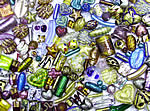Le perle furono ampiamente usate dagli europei per il commercio con gli indigeni nelle terre coloniali di tutto il mondo; si dice che nel 1626 l’olandese Peter Minnit abbia comprato l’isola di Manhattan dagli indiani per un valore totale di ventiquattro dollari in perle di vetro.
L’arte della lavorazione della perla raggiunse un ottimo livello di qualità agli inizi dell’impero romano con la produzione del mosaico millefiori che si otteneva sovrapponendo sessioni di vetro recanti un motivo decorativo e saldati assieme al calore.
Durante il medioevo l’arte del vetro venne temporaneamente abbandonata così come l’arte della perla, ma fu presto ristabilita dagli artigiani mercanti Veneziani prima dell’anno 1000 D.C. e da allora le più belle perle del mondo si fanno a Venezia.
Da più di mille anni successive generazioni di artisti si passano gelosamente le conoscenze di questa antica lavorazione.
A Venezia oggi il lavoro manuale continua e le meravigliose perle fatte con il vetro di Murano, le splendide decorazioni dal sapore romantico, le trasparenze che evidenziano le lavorazioni in oro, le forme e i colori sono conosciute in tutto il mondo semplicemente con il nome di Perle Veneziane.
 The
art of bead making has been developing together with the glass art; at
first, beads were just pieces of glass with a hole in the middle or set
in a frame.
The
art of bead making has been developing together with the glass art; at
first, beads were just pieces of glass with a hole in the middle or set
in a frame.
Very soon the beads handworking developed into a large-scale production
and beads were not only used as ornaments for women but also as money
and in barters.
Beads were widely used by the Europeans in the trading with natives in
the colonial countries all over the world; they said that in 1626 the
Dutch Peter Minnit bought Manhattan Island from Indians with glass beads
for a total value of $ 24.
The art of bead working reached a very good quality at the beginning
of Roman Empire with the mosaic “millefiori” production,
which was obtained by putting some glass pieces, with different decorative
patterns,
one on another and welding them together.
During the Middleages the glass bead art was temporarily abandoned but
it was soon re-established by the Venetian artisans before 1000 A.C. Since
that period the most beautiful glass beads are made in Venice.
 La
lavorazione delle perle è una tecnica antichissima, I nostri predecessori
colavano il vetro con un lume ad olio e lo incorporavano in un filo di
metallo precedentemente immerso in una pasta di gesso e caolino cosicché
al raffreddamento si potesse sfilare il metallo e rimanesse il foro; ovviamente
il foro e la forma erano molto irregolari, caratteristica tra l’altro
delle perle antiche.
La
lavorazione delle perle è una tecnica antichissima, I nostri predecessori
colavano il vetro con un lume ad olio e lo incorporavano in un filo di
metallo precedentemente immerso in una pasta di gesso e caolino cosicché
al raffreddamento si potesse sfilare il metallo e rimanesse il foro; ovviamente
il foro e la forma erano molto irregolari, caratteristica tra l’altro
delle perle antiche.